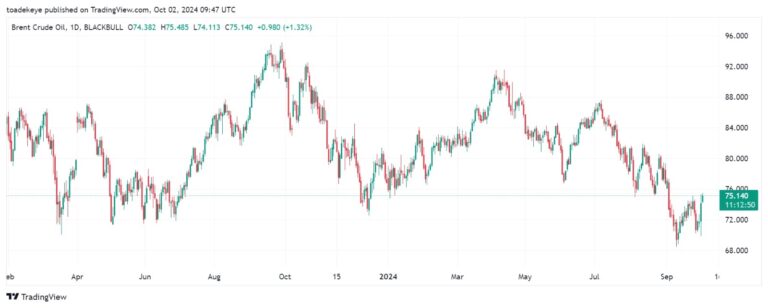Post Views:
115
Peace Nnachi, ACA
Research Analyst
Oil prices surged about 3% on Tuesday after Iran fired a salvo of ballistic missiles at Israel in retaliation for Israel’s campaign against Tehran’s Hezbollah allies in Lebanon.
Brent futures increased by 2.6% to settle at $73.56 a barrel, while U.S. West Texas Intermediate (WTI) crude was up by 2.4% to settle at $69.83.
China’s Factory Activity Declines for the Fifth Month in a row, Services Sector Slows
China’s factory activity contracted for the fifth consecutive month in September, while the services sector saw a sharp slowdown. The Purchasing Managers’ Index (PMI) for manufacturing slightly improved to 49.8 from 49.1 in August but remained below the 50-mark, indicating ongoing contraction. Meanwhile, the services PMI fell to 49.9, signalling its first decline since December 2022. Despite recent aggressive government stimulus, including property market support and a 2 trillion yuan bond package, analysts say weak consumer demand and global trade challenges remain major obstacles to achieving China’s 2024 growth target of around 5%.
Saudi Oil May Keep Lid On Middle East Fallout
The escalating conflict in the Middle East has led to significant consequences, including a major decline in Palestine’s GDP and fluctuating oil prices between $70 and $80 per barrel. The potential closure of the Strait of Hormuz poses a threat to global oil supply. Saudi Arabia, a key player in OPEC, has reduced its production to 9 million barrels per day, causing frustration among other OPEC members. Due to weak demand and competition from non-OPEC countries, Saudi Arabia may increase production and possibly reverse some cuts by December to stabilize global oil prices.
BHP’s Copper Demand Forecast: Significant Growth Ahead
BHP forecasts that global copper consumption will rise by an average of 1 million metric tonnes per year until 2035, driven by the adoption of copper-intensive technologies. While copper demand has historically grown at 3.1% annually over the last 75 years, it slowed to 1.9% between 2007 and 2021 but is expected to rebound to 2.6% by 2035. The Escondida mine reported a total copper demand of 31 million tons in 2023. By 2050, BHP predicts a 70% increase in global copper demand, reaching 50 million tonnes annually, with the energy transition sector projected to account for 23% of that demand. However, rising costs and declining ore grades may limit copper mining output growth, prompting BHP to anticipate a significant rise in spending on copper projects to $250 billion from 2025 to 2034.
Nigeria Sees 3.58 Billion Litre Decline in Petrol Imports Following Subsidy Removal
Nigeria has experienced a notable decrease in petrol imports after President Bola Tinubu’s removal of the fuel subsidy in May 2023. Petrol imports declined by 3.58 billion litres in the latter half of 2023 compared to the first half.
In H1 2023, the country imported 8.36 billion litres of Premium Motor Spirit (PMS), down from 11.94 billion litres in the first half, amounting to 29.99% reduction. This decline is even more striking compared to the same period in 2022, when imports were 11.98 billion litres, reflecting a 30.22% decrease in 2023.
Additionally, Nigeria’s fuel import costs decreased by approximately 2.6% in 2023. In the second half, the country spent N3.5 trillion on fuel imports, a 10.26% drop from the N3.9 trillion spent in the first half. However, in early 2024, petrol imports costs surged by 87.09%, driven by high crude oil prices and a weakened Nai00ra.








